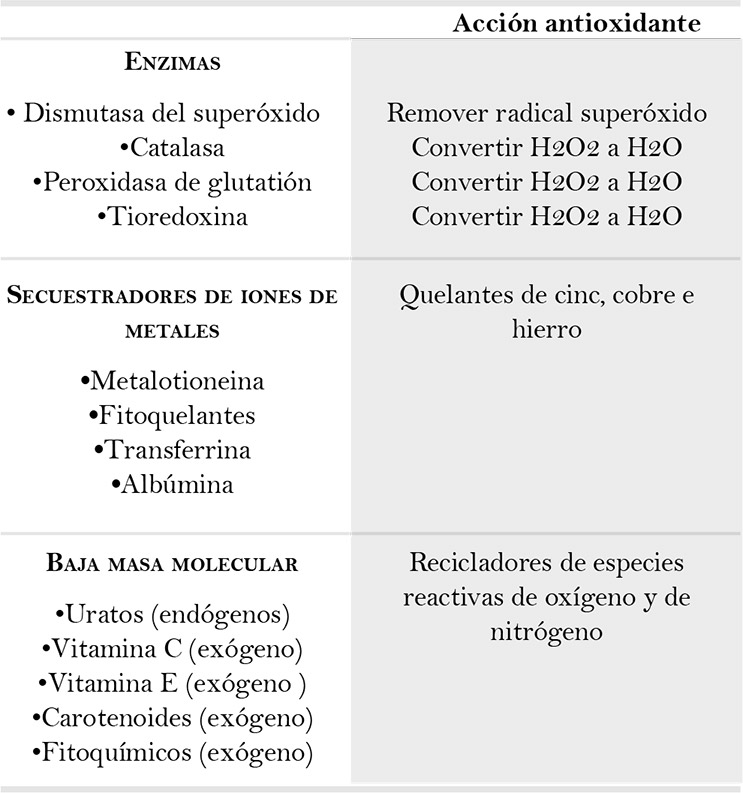Estrés oxidativo y antioxidantes: cómo mantener el equilibrio
Palabras clave:
antioxidantes, estrés oxidativo, oxidación, enzimasResumen
El estrés oxidativo originado por altas concentraciones de radicales libres y especies reactivas, derivadas de radicales o no, se considera causa de daño a los organismos vivos y a sus constituyentes celulares, de cáncer, de infecciones, de envejecimiento y de enfermedades inflamatorias y degenerativas, entre otras.
Sin embargo, algunos de ellos, como el óxido nítrico, son necesarios e importantes para los procesos de señalización y otras funciones fisiológicas, como por ejemplo, el mantenimiento del tono vascular y la tensión de oxígeno, y para la producción de eritropoyetina.
Los tratamientos e investigaciones se enfocan cada vez más hacia cómo mantener el equilibrio o restablecer la homeostasis de óxido- reducción, para tratar los procesos patológicos y favorecer los fisiológicos.
Biografía del autor/a
Sara María Lozada
Servicio de Dermatología, Universidad del Valle, Cali, Colombia
Lucy García
Facultad de Ciencias Básicas Médicas, Universidad del Valle, Cali, Colombia
Referencias bibliográficas
2. Halliwell B, Gutteridge JMC. Oxidative stress: Adaptation, damage, repair and death. In: Halliwell B, Gutteridge JMC. Free radicals in biology and medicine. 3rd edition. New York: Oxford University Press; 1999.
3. Halliwell B, Whiteman M. Measuring reactive species and oxidative damage in vivo and cell culture. How should you do it and what does it mean? Br J Pharmacol. 2004;142:231-55.
4. Halliwell B. Free radicals and antioxidants: a personal view. Nutrition Reviews. 1994;52:253-65.
5. Opara E. Oxidative stress. Dis Mon. 2006;52:183-98.
6. Turrens J. Superoxide production by the mitochondrial respiratory chain. Biosci Rep. 1997;17:3-8..
7. Beckman JS, Koppenol WH. Nitric oxide, superoxide and peroxynitrite: the good, the bad, and ugly. Am J Physiol. 1996;271:1424-37.
8. Haliwell B. Reactive species and antioxidants. Redox biology is a fundamental theme of aerobic life. Plant Physiol. 2006;141:312-22.
9. Thannickal VJ, Fanburg BL. Reactive oxygen species in cell signaling. Am J Physiol-Lung Cell Mol Physiol. 2000;279:1005-28.
10. Ghafourifar P, Cadenas E. Mitochondrial nitric oxide synthase. Trends Pharmacol Sci. 2005;26:190-95.
11. Lau D, Baldus S. Myeloperoxidase and its contributory role in inflammatory vascular disease. Pharmacol Ther. 2006;111:16-26.
12. Mc Adam BF, Mardini IA, Habib A, Burke A, Lawson JA, Kapoor S, et al. Effect of regulated expression of human cyclooxygenase isoforms on eicosanoid and isoeicosanoid production in inflammation. J Clin Invest. 2000;105:1473-82.
13. Liu W, Rosenberg G A, Shi H, Furuichi T, Timmins GS, Cunningham LA, et al. Xanthine oxidase activates pro-matrix metalloproteinase-2 in cultured rat vascular smooth muscle cells through non-free radical mechanisms. Arch Biochem Biophys. 2004;426:11-17.
14. Willcox J, Ash S, Catignani G. Antioxidants and prevention of chronic disease. Crit Rev Food Sci Nutr. 2004;44:275-95.
15. Hensley K, Robinson KA, Gabbita SP, Salsman S, Floyd RA. Reactive oxygen species, cell signaling, and cell injury. Free Radic Biol Med. 2000;28:1456-62.
16. Halliwell B. Phagocyte-derived reactive species: salvation or suicide? Trends Biochem Sci. 2006;31:509-15.
17. Rhee SG. Cell signaling. H2 O2, a necessary evil for cell signaling. Science. 2006;312:1882-3.
18. Pire L, Deby-Dupont G, Lemineur T, Preiser JC. How to keep oxidative stress under control. Curr Nutr Food Sci. 2007;3:222-35.
19. Lee PJ, Choi AMK. Pathways of cell signaling in hyperoxia. Free Radic Biol Med. 2003;35:341-50.
20. Wang X, Martindale JL, Liu Y, Holbrook NJ. The cellular response to oxidative stress: influences of mitogen-activated protein kinase signalling pathways on cell survival. Biochem J. 1998;15:291-300.
21. Shameer P, Prasad PVS, Kaviarasan PK. Serum zinc level in vitiligo: A case control study. Indian J Dermatol Venereol Leprol. 2005;71:206-7.
22. Navarro C, Bustos ML. Esclerosis sistémica etiopatogenia, nuevos conceptos. Reumatol Clin. 2006;2(Suppl.3):S6-9.
23. Droge W. Free radicals in the physiological control of cell function. Physiol Rev. 2002;82:47-95.
24. Mates J M, Pérez-Gómez C, De Castro IN. Antioxidant enzymes and human diseases. Clin Biochem. 1999;32:595-603.
25. DeCoursey TE, Ligeti E. Regulation and termination of NADPH oxidase activity. Cell Mol Life Sci. 2005;62:2173-93.
26. Masella R, Di Benedetto R, Vari R, Filesi C, Giovannini C. Novel mechanisms of natural antioxidant compounds in biological systems: Involvement of glutathione and glutathione related enzymes. J Nutr Biochem. 2005;16:577-86.
27. Evans MD, Dizdaroglu M, Cooke MS. Oxidative DNA damage and disease: induction, repair and significance. Mutat Res. 2004; 567:1-6.
28. Preiser JC, Wernerman J. Glutamine, a life-saving nutrient, but why? Crit Care Med. 2003;31:2555-6.
29. Walsh TS, Lee A. N-acetylcysteine administration in the critically ill. Int Care Med. 1999;25:432-4.
30. Evans P, Halliwell B. Micronutrients: oxidant/antioxidant status. Br J Nutr. 2001;85(Suppl.2):S67-74.
31. Vertuani S, Angusti A, Manfredini S. The antioxidants and pro-antioxidants network: an overview. Curr Pharm Des. 2004;10:1677-94.
32. Halliwell B, Rafter J, Jenner A. Health promotion by flavonoids, tocopherols, tocotrienols, and other phenols: direct or indirect effects? Antioxidant or not? Am J Clin Nutr. 2005;81:268-76.
33. Schwedhelm E, Mass R, Troost R, Böger RH. Clinical pharmacokinetics of antioxidants and their impact on systemic oxidative stress. Clin Pharmacokinet. 2003;42:437-59.
34. Lee CY, Isaac HB, Huang SH, Long LH, Wang H, Gruber J, et al. Limited antioxidant effect after consumption of a single dose of tomato sauce by young males, despite a rise in plasma lycopene. Free Radic Res. 2009;43:622-8.
35. Tham DM, Gardner CD, Haskell WL. Potential health benefits of dietary phytoestrogens: a review of the clinical, epidemiological, and mechanistic evidence. J Clin Endocrinol Metab. 1998;83:2223-35.
36. Salah N, Miller NJ, Paganga G, Tiburg L, Bolwell GP, RiceEvans C. Polyphenolic flavanols as scavengers of aqueous phase radicals and as chain-breaking antioxidants. Arch Biochem Biophys. 1995;322:339-46.
37. Opara E, Rockway S. Antioxidants and micronutrients. Dis Mon. 2006;52:151-63.
38. Valko M, Leibfritz D, Moncol J, Cronin MT, Mazur M, Telser J. Free radicals and antioxidants in normal physiological functions and human disease. Int J Biochem Cell Biol. 2007;39:44-84.
39. Rees M, Kennett E, Whitelock J, Davies M. Oxidative damage to extracellular matrix and its role in human pathologies. Free Radical Biology & Medicine. 2008;44:1973-2001.
40. Flores-Mateo G, Carrillo-Santisteve P, Elosua R, Guallar E, Marrugat J, Bleys J, et al. Antioxidant enzyme activity and coronary heart disease: meta-analyses of observational studies. Am J Epidemiol. 2009;170:135-47.
41. Choi SW, Benzie I, Ma SW, Strain J, Hannigan B. Acute hyperglycemia and oxidative stress: Direct cause and effect? Free Radic Biol Med. 2008;44:1217-31.
42. Parihar A, Parihar M, Milner S, Bhat S. Oxidative stress and anti-oxidative mobilization in burn injury. Burns. 2008;34:6-17.
43. Biesalski H, McGregor G. Antioxidant therapy in critical care -is the microcirculation the primary target? Crit Care Med. 2007;35:S577-83.
44. Patel S, Sigman M. Antioxidant therapy in male infertility. Urol Clin North Am. 2008;35:319-30.
45. Sun AY, Wang Q, Simonyi A, Sun GY. Botanical phenolics and brain health. Neuromolecular Med. 2008;10:259-74.
46. Ghersetich I, Troiano M, De Giorgi V, Lotti T. Receptors in skin ageing and antiageing agents. Dermatol Clin. 2007;25:655-62.
47. Mashima R, Witting PK, Stocker R. Oxidants and antioxidants in atherosclerosis. Curr Opin Lipidol. 2001;12:411-8.
48. Maritim AC, Sanders RA, Watkins JB. Diabetes, oxidative stress and antioxidants. J Biochem Mol Toxicol. 2003;17:24-37.
49. Franco R, Schoneveld O, Georgakilas A, Panayiotidis M. Oxidative stress, DNA methylation and carcinogenesis. Cancer Lett. 2008;266:6-11.
50. Goetz M, Luch A. Reactive species: A cell damaging rout assisting to chemical carcinogens. Cancer Lett. 2008;266:73-83.
51. Sander CS, Chang H, Hamm F, Eslner P, Thiele JJ. Role of oxidative stress and antioxidant network in cutaneous carcinogénesis. Int J Dermatol. 2004;43:326-35.
52. Bjelakovic G, Nikolova D, Gluud LL, Simonetti RG, Gluud C. Mortality in randomized trials of antioxidant supplements for primary and secondary prevention. Systematic review and meta-analysis. JAMA. 2007;297: 842-57.
53. Hermans N, Cops P, Maes L, De Bruyne P, van den Berghe D, Vliethinck AJ, et al. Challenges and pitfalls in antioxidant research. Curr Med Chem. 2007;14:417-30.
54. Steinhubl S. Why have antioxidants failed in clinical trials? Am J Cardiol. 2008;101:14D-19D.
Cómo citar
Descargas

Descargas
Publicado
Cómo citar
Número
Sección
| Estadísticas de artículo | |
|---|---|
| Vistas de resúmenes | |
| Vistas de PDF | |
| Descargas de PDF | |
| Vistas de HTML | |
| Otras vistas | |






